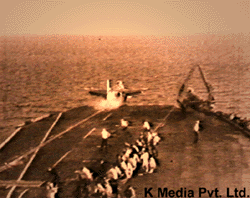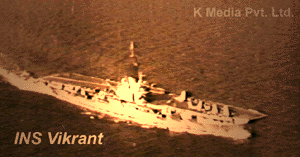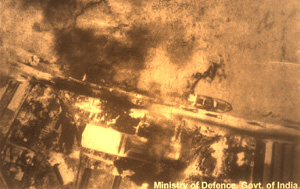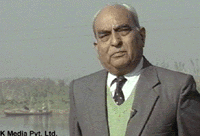![[Image: JPG Image og Indian Tank in Pakistani Territory; Caption: 1971 India-Pakistan War]](./media/1971WarPagesBanner.jpg)
![[Image: JPG Image og Indian Tank in Pakistani Territory; Caption: 1971 India-Pakistan War]](./media/1971WarPagesBanner.jpg)
| |
Using Sea Power Since East and West Pakistan were two separate geographical entities
more than 1,600 miles apart, the only way Pakistani forces in East Pakistan
could be sustained was through the sea. The Indian Prime Minister, Mrs.
Indira Gandhi, decided that the Navy would be given the strategic task
of denying both East and West Pakistan access to war supplies. The aim
in short was a complete naval blockade of both parts of Pakistan. The bigger
aim was of course to ensure that the conflict was not perpetuated beyond
the time required to capture a chunk of East Pakistani territory.
The Indian Navy's best and biggest warship at that time was its sole
aircraft carrier, INS Vikrant, a carefully preserved World
War II vintage carrier built in Britain. Ideally, a task force centred
around the Vikrant should have been used to block Karachi, which
at that time was West Pakistan's sole deep water port. However, one of
Vikrant's main boilers was out of operation and the ship could not
maintain the kind of speed required for manoeuvring in a situation where
the air threat would be considerable. It was decided that the Vikrant
would be used to blockade the ports in East Pakistan, and destroy the riverine
craft used by the Pakistanis there.
 The 1971 war was the first, and only, occasion when the Indian political
leadership exhibited a proper understanding of the use of military power
for achieving a clear national aim. In past conflicts, Indian leaders either
had no clear aim in mind and were merely reacting to events or they were
confused about how best to use the military power available to them. During
the 1962 India-China war, for instance, the Indian government ordered the
Indian Air Force to withdraw its fighter bomber squadrons from the north
east and not to hit the invading Chinese. IAF bombers could have changed
the course of the 1962 war had it been allowed to hit the thin and tenuous
Chinese logistics lines. Similarly, in the 1965 India-Pakistan conflict,
the Navy was ordered to keep its ships in port and not engage in any offensive
action against Pakistan. The Pakistani Navy was given a free hand and it
managed to lob a few shells at one point in the Western Coast. The Indian
Navy's chance to see some action came only in 1971 December.
The 1971 war was the first, and only, occasion when the Indian political
leadership exhibited a proper understanding of the use of military power
for achieving a clear national aim. In past conflicts, Indian leaders either
had no clear aim in mind and were merely reacting to events or they were
confused about how best to use the military power available to them. During
the 1962 India-China war, for instance, the Indian government ordered the
Indian Air Force to withdraw its fighter bomber squadrons from the north
east and not to hit the invading Chinese. IAF bombers could have changed
the course of the 1962 war had it been allowed to hit the thin and tenuous
Chinese logistics lines. Similarly, in the 1965 India-Pakistan conflict,
the Navy was ordered to keep its ships in port and not engage in any offensive
action against Pakistan. The Pakistani Navy was given a free hand and it
managed to lob a few shells at one point in the Western Coast. The Indian
Navy's chance to see some action came only in 1971 December.
Vikrant in Action "Fighter pilots practice for years and when they finally get an
opportunity to see real action, it is thrilling - it is the moment one
has been waiting for all one's life. And it was so for us aboard the Vikrant
on 4th December 1971...
"The first sortie was mounted against Cox's Bazaar. Eight Sea Hawks
went in led by the squadron commander. I was in the second sortie which
attacked Chittagong. This was in the afternoon of the 4th because it took
some time for the Vikrant to close in the range to Chittagong.
"We went in low level, pulled up and carried out repeated attacks
on the airfield. In the first attack itself we inflicted considerable damage.
We withdrew for the night and sailed towards the Mangla-Khulna area. Our
next attacks were on those harbours. Then we came back to Chittagong. And
by the time we were through with that area, especially Chittagong harbour,
Chittagong airfield and the approaches to Chittagong, the scene was something
to be seen. The place had been devastated. There were ships that had turned
turtle, there were half-sunk ships by the quay side, the airfield was pockmarked
with craters and no ship could even think of approaching the place."
 The day war was declared, the Vikrant, which had been anchored
off the northern-most tip of the Andaman & Nicobar chain of islands,
moved towards the principal East Pakistani port, Chittagong. The Pakistanis,
having learnt that Vikrant was positioned in the Bay of Bengal,
despatched one of their submarines, PNS Ghazi, to the east. The
Pakistani submarine thought it could sneak into Vizag harbour, the principal
naval port in the Indian east coast. It was, however, detected and sunk
before it could cause any damage. The Vikrant continued unhindered.
Rear Admiral (retired) P.D.Sharma, who was then an aviator aboard the Vikrant,
recalls what it was like:
The day war was declared, the Vikrant, which had been anchored
off the northern-most tip of the Andaman & Nicobar chain of islands,
moved towards the principal East Pakistani port, Chittagong. The Pakistanis,
having learnt that Vikrant was positioned in the Bay of Bengal,
despatched one of their submarines, PNS Ghazi, to the east. The
Pakistani submarine thought it could sneak into Vizag harbour, the principal
naval port in the Indian east coast. It was, however, detected and sunk
before it could cause any damage. The Vikrant continued unhindered.
Rear Admiral (retired) P.D.Sharma, who was then an aviator aboard the Vikrant,
recalls what it was like:

Leading the missile boat squadron was Commodore (Retired) Babru Bahan
Yadav:"The task given to us was not easy. Our ships were little more
than boats and did not have the range to go all the way to Karachi on their
own steam. So an oiler was placed about half-way to the target and we were
able to refuel and carry on.
"As we neared their coast, we found some of their ships patrolling
the area. The boat on my left was detailed to engage the contact. That
boat was the first Indian warship to fire a missile in anger. Two missiles
were fired and both were direct hits. It is interesting to recall that
the radar contact which was on our screen slowly diminished and then suddenly
disappeared. We were very jubilant at that time. Later, we found that this
has been a Pakistani destroyer.
Very soon another ship was located right in front of my boat. We fired
a couple of missiles as well but did not sink it. The boat on our right was
ordered to attack the ship. It did so and managed to cripple it completely.
We thought we had sunk it but later the Pakistanis claimed that the ship
had been badly crippled and put out of action but not sunk. Anyway, as
we continued, both the other boats could not keep up and had to turn back.
Only Nipat, the boat I was on, could proceed towards Karachi harbour.
We pressed on and fired missiles on Karachi which hit the oil installations
there. The attack took place just 1 minute before midnight and we could
see the flames from the oil installations lighting up the sea. It looked
like Diwali (Indian festival of lights and firecrackers)."
It took a few more days for Commodore Yadav's boat to return to harbour
as they had to take evasive action and ran out of fuel. In the meanwhile,
the Pakistanis who were hunting for the boat put out a message that an
Indian vessel had been sunk. Nipat, the only boat not accounted
for at that time, was presumed sunk. But Nipat returned, thanks
to the ingenuity of its engineers who managed to take out pump oil and
use it to run the engines.
The Indian Navy accomplished the task assigned to it within the first few days of the war. No enemy shipping could move in or out of its harbours. Merchant ships did not dare approach Karachi. Control of the seas around both wings of Pakistan was with the Indian Navy.  The Attack on Karachi
The Attack on Karachi
The most dramatic naval plan was drawn up by the Western Naval Command.
It was decided that the main attack on Karachi harbour would be launched
by tiny PT-15 missile boats instead of regular warships. There were several
reasons for this decision. Regular ships without air cover would be vulnerable
whereas the tiny missile boats would present difficult, fast-moving targets.
Moreover, the Navy wanted to try out the missiles to see how effective
they could be in real action, although this kind of use of missile boats,
which were designed for coastal defence and not for long range offensive
action of any kind, was highly unorthodox. At any rate, three missile boats
were chosen for the mission and despatched in the dead of night from Bombay
harbour.

Next: Part Five: The Battle of Longewal